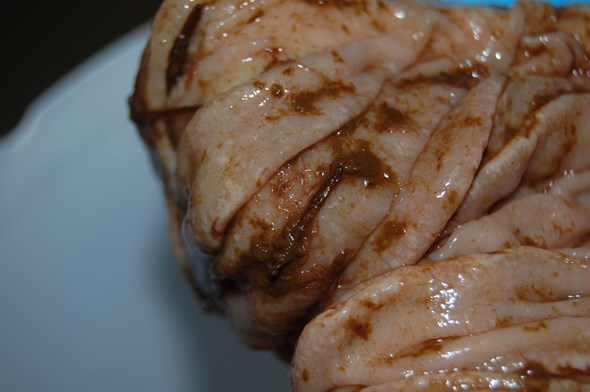Look out for Haemonchus in sheep and goats!

Photo of abomasum showing signs of concurrent parasitism as well as Haemonchus
Colleagues in Aberdeen have seen several sheep and goats with Haemonchus over the last few weeks. These relatively large barbers pole worms are found in the abomasum and cause anaemia and hypoproteinaemia by taking blood meals from the host. In a fresh carcase they can be seen by the naked eye. They are highly pathogenic and as few as 1500 worms can cause death.
Haemonchus is originally a tropical parasite, which we are seeing increasingly in the area. They are extremely fecund, with worm egg counts often reaching over 10,000 eggs per gram. Combine this fecundity with warm, wet weather and large numbers of infective larvae can build up on pastures quickly. Sheep do not develop immunity to Haemonchus like they do other worms, and all ages of animal can develop disease.
Clinical presentation can be as sudden deaths in any age of animal. Examination of the group will reveal clinical signs including anaemia, lethargy, ill thrift, submandibular oedema and dark faeces. Acute fascioliasis is the main differential, and the two can be easily differentiated on an on farm post-mortem examination. Very high strongyle counts are supportive, but care with pooled samples – a low to moderate count doesn’t exclude a diagnosis of haemonhcus. We can do a peanut agglutinin test to identify Haemonchus eggs, which may be useful for detecting its presence on a farm.
All groups of anthelmintics will treat Haemonchus, although due to the fecundity of the worm and the temptation to treat all animals is a group, there is concern about the development of resistance. Closantel and nitroxynil also have efficacy against Haemonchus and may be useful products to reduce selection pressure on anthelmintics. In farms with an identified Haemonchus problem, using closantel or perhaps a group 4 or 5 wormer in the late autumn could be considered to reduce hypobiosis and overwintering of worms in adult animals, and therefore the subsequent pasture contamination during the periparturient rise in the spring.
Posted by SRUC Veterinary Services on 11/10/2021
